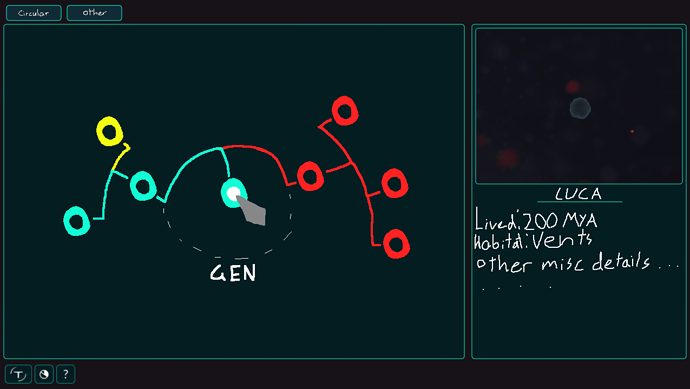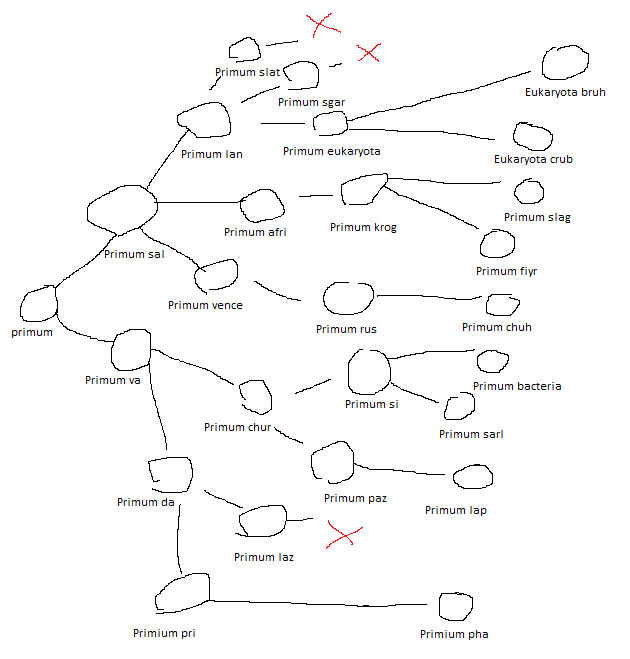Here is a concept to adding microbial filaments e.g. external proteins, cilia, chemoreceptors, thermoreceptors, lamellipodia, etc.:
You could scale the speed at which the reaction happens with how much iron you have. This would create 2 rather different playstyles which both use iron, one where you stockpile it to boost your hydrogenase, and one where you consume it. You could even try both at the same time, but you’d have to take care to gather enough iron that your hydrogen consumption doesn’t tank.
I do like your idea of oxygen and light hampering the reaction, since it would make sure that the reaction would only work in the early game, before the great oxygenation.
Is this not on purpose though? Reproducing should be a difficult feat, and being in the progress of it should hamper you. You have to create the organelles anyway to be able to split, so might as well use them then.
I really like this, you could use them to trap smaller cells and kill them without engulfing them to save time, but it would require a couple mutations first.
IIRC there’s a planned flagellum-based organelle which can attach itself to physical objects that drift around. (E.G. iron or drifting calcium particles)
When playing as a small cell you have very few organelles. So duplication of organelles has a drastic effect on your cells viability. flagella are basically impossible to play with on a small scale because your cell is too busy dying of starvation after reaching 50% progress on your reproduction bar and duplicating its flagella.
This effect scales down as your cell increases in size as organelles become more “even” so duplicated organelles have less of an effect on your cells viability. But it also results in you losing control of your cell once you reach a certain size. so sometimes after reaching X% of my duplication progress i’ll be stuck as a moderately sized cell with too many thykaloids and not enough metabolosomes. so i’m no longer at risk of dying of starvation from atp over usage but i have to constantly pause every few seconds until i find some phosphate/ammonia to finally duplicate some metabolosomes which is somewhat annoying.
if i try to get bigger to even out the organelles so that duplication doesn’t have too much of an effect gameplay basically slows down dramatically and duplication becomes hard due to the loads of ammonia and phosphorus i need to obtain
I don’t think there’s anything wrong with complexity when utilized correctly. But, my main problem would probably have to do with the unpredictability of the duplication. it just seems like the way organelle duplication works right now is just an unnecessary added layer of complexity and for me its just not fun. maybe if there was some way to plan out stages of organelle duplication/prioritize the duplication of certain organelles it would be easier, i don’t know.
That is true, getting a bar or something where you can rearrange the order of the splitting organelles would be a pretty good addition.
Hey, I’m glad someone liked my idea. I never got any feedback for it, but I saw hydrogenase in a developer list of possible features, so I was satisfied.
There should be a way to create phosphate u can create ammonia so can u add a organelle that creates phosphate so then you dont have to worry about finding it?
I mean, realistically, you can’t really just generate phosphate as phosphor isn’t very common naturally; The reason you can make ammonia is because nitrogen and hydrogen (The ingredients of ammonia) are both very common.
Gameplay wise, having you able to just make phosphate means that you can automate the game so that you can win without any input (and I personally think you should have to put in slight effort to win).
Isn’t that what plant gameplay will be? Like honestly going for a plant run where I just have it run in the background without me interfering could be pretty fun.
Even plants need to collect resources like phosphate or potassium (It’s part of why they have roots).
But I see what you mean, having the game play itself without any input could be fun, but I would rather it dictated by how you designed your organism to automatically grow and collect, rather then pulling resources out of thin air. Some resources that can be generated are fine, but some shouldn’t be obtainable by just the editor
The only way I see this as ‘working’ is that its an organ that can store phosphate for desperate times, like if you can’t find any it releases some.
Gameplay wise, you can’t use it until it releases it it self.
Isn’t that just a vacuole with an additional restriction to not get its contents unless some condition is met?
You can just load up on vacuoles and store enough phosphates at once to win the game.
IIRC flows are going to be added, which would allow players without movement organelles to still move around, albeit by chance. (The same way algae do)
a few days ago I was playing on thrive and decided to actually change my species name when I noticed that you are actually required to follow something resembling the binomial naming system and that got me thinking about how the game would handle classifying/naming life.
So using binomial nomenclature implies taxa (eg kingdoms and phyla) are already in existence; This probably wouldn’t work considering that we begin the game as the Last universal common ancestor on the planet. in addition to the fact that all taxa with the exemption of species are arbitrary I don’t think the game should attempt to follow taxonomy for the sake of familiarity. I believe that it would be better if the whole binomial naming schtick was scrapped and we just got randomly generated specie names instead.
And while we’re on the topic of classification of life it got me thinking about cladograms so i made a little mock up of what i think a cladogram implemented in thrive could possibly look like:
so essentially its just a cladogram but simplified. each new ring/generation represents a new generation (after you finish an editor session and the cpa system does its thing) you can trace your species lineage back (its the cyan lineage) and the other clades only get colors once they diverge from your species. (i haven’t thought too much about the coloration. maybe it would be better if the lines and nodes were all just white except for your species lineage i’m not sure)
each exterior node is a species and all inner nodes are clades. For the sake of simplicity clades should be named after their species. so looking at the cladogram immediately once you begin the microbe stage would show you one single node which would be the species LUCA. then after a generation the LUCA node will have become a clade . (also, I forgot to include it but there should probably be a search bar in there so you can search up a species or a clade.) Then on the right panel you can see the node you selected and see the species and miscellaneous details about it such as its habitat, speed, size, and when it lived.
I like both the idea and the UI. One thing that really captures my interest is the fact that you will have to “zoom in” because the circles get smaller and smaller.
The cladogram looks cool. I think it should display a little image of each species inside the circle; I don’t know about you but I always identify the species by how they look instead of remembering their names.
As for the naming I think the current system works alright. It looks very scientific, with the genus and species name, and I don’t mind that it implies taxonomy exists. Just because geni exist doesn’t have to mean the taxonomy has anything to do with Earth. I find the names aren’t very memorable, though. Maybe, just like most animals irl, species should have a scientific and a common name, with the common name being overwritable by the player so he can give the species nicknames.
sorry i should’ve worded by post a bit clearer. An issue I see arising from using binomial nomenclature is that in the beginning geni wouldn’t exist. to make my point more clear;
humans are split into 7 major taxa. Eukarya, metazoa, chordata, mammalia, primate, homonidae, homo, and then finally the species Sapiens. How do you think the last universal common ancestor on earth would have been classified according to the linaean system? What kingdom would it have belonged to, what phyla, what genus? All Taxa with the exemption of species are all arbitrary human constructs we use to categorize life. and doesn’t make sense using it.
yeah you have to write 2 words for your species name otherwise it doesn’t work

![]()
- Primum (LUCA)
- Primum bacteria
- Primum archaea
- Primum eukaryota
- Eukaryota archaeplastida
- Archaeplastida plantae
- Eukaryota opisthokonta
- Opisthokonta animalia
- Opisthokonta fungi
- Eukaryota archaeplastida
Right?
At what point do we consider something to become a taxa? you’ve given an example where “Primum eukaryota” would be a species name with “Primum” connoting its genus and “eukaryota” connoting its actual species. The transition from LUCA to this new “Primum eukaryota” species must have taken many editor sessions. why does the genus “primum” stay a genus and prevent the numerous previous specie names from becoming a genus? what makes “Primum” so special? then there is “Eukaryota archaeplastida” why does eukaryota become a genus now instead of the many other species names that came before it? why does eukaryota unlike all the prior species supersede primum and become a genus? ( presumably pushing back primum into the “family” taxa. )
I’m not great with words and explaining my thoughts so i tend to find its easier to explain to people what i mean through visuals.
The evolution from Primum/primium (they’re the same thing i just mixed them up and forgot to fix it) to primium eukaryota took 2 generations. Why does the species name “eukaryota” get selected for as a genus instead of “lan” or “sal”


